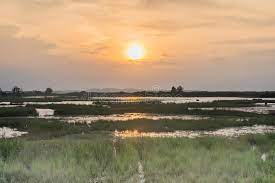CURRENT AFFAIRS
Get the most updated and recent current affair content on Padhaikaro.com
Four New Ramsar Sites
- Vaid's ICS, Lucknow
- 15, Dec 2021

Why in news?
According to recent estimates by Wetlands International South Asia, nearly 30% of the natural wetlands in India have been lost in the last three decades. Majorly, the loss of Wetlands is more prominent in Urban areas.
- Wetlands International South Asia was established in 1996, with an office in New Delhi, as a part of Wetlands International network to promote conservation and sustainable development of wetlands in the South Asia region.
About Wetlands:
- Wetlands are ecosystems saturated with water, either seasonally or permanently.
- They include mangroves, marshes, rivers, lakes, deltas, floodplains and flooded forests, rice-fields, coral reefs, marine areas no deeper than 6 metres at low tide, as well as human-made wetlands such as waste-water treatment ponds and reservoirs.
- Though they cover only around 6% of the Earth’s land surface, 40% of all plant and animal species live or breed in wetlands.
New Ramsar Sites:
- Recently, the Ramsar Convention has designated four new wetlands in India, as wetlands of global importance. It is an international treaty for the conservation and wise use of wetlands.
- Bhindawas Wildlife Sanctuary, the largest wetland in Haryana is a human-made freshwater wetland.
- Sultanpur National Park from Haryana supports more than 220 species of resident, winter migratory and local migratory waterbirds at critical stages of their life cycles.
- Thol Lake Wildlife Sanctuary in Gujarat lies on the Central Asian Flyway and more than 320 bird species can be found here.
- Wadhwana Wetland from Gujarat is internationally important for its birdlife as it provides wintering ground to migratory water birds, including over 80 species that migrate on the Central Asian Flyway.
- These wetlands are home to endangered bird species like Egyptian Vulture, Saker Falcon, Sociable Lapwing, and the near threatened Dalmatian Pelican.
- With this, the number of Ramsar sites in India are 46.
Facts for Prelims:
World’s second-largest refurbished gene bank
- Agriculture Minister Narendra Singh Tomar inaugurated the world’s second-largest refurbished gene bank at the National Bureau of Plant Genetic Resources in New Delhi.
- The National Gene Bank was established to preserve the seeds of Plant Genetic Resources (PGR) for future generations. It has a capacity to preserve about one million germplasm in the form of seeds.
- This revamped National Gene Bank is an important step towards the conservation of the diversity of indigenous crops in the country.
- At present, the need of bio-fortified crop varieties has increased. The agri-farmers would be greatly benefited by the new gene bank facilities for germplasm.
The ‘Incel’ Movement:
The ‘incel’ movement, a dangerous online subculture comprising men who identify as ‘involuntary celibates’ and regularly express deeply misogynistic views about women, is slowly becoming a threat to law and order, experts have warned.
- Incels are a largely online community of men who describe themselves as “involuntary celibates.
- Men who are part of this movement harbour a deep resentment towards both women and other men who are sexually active.